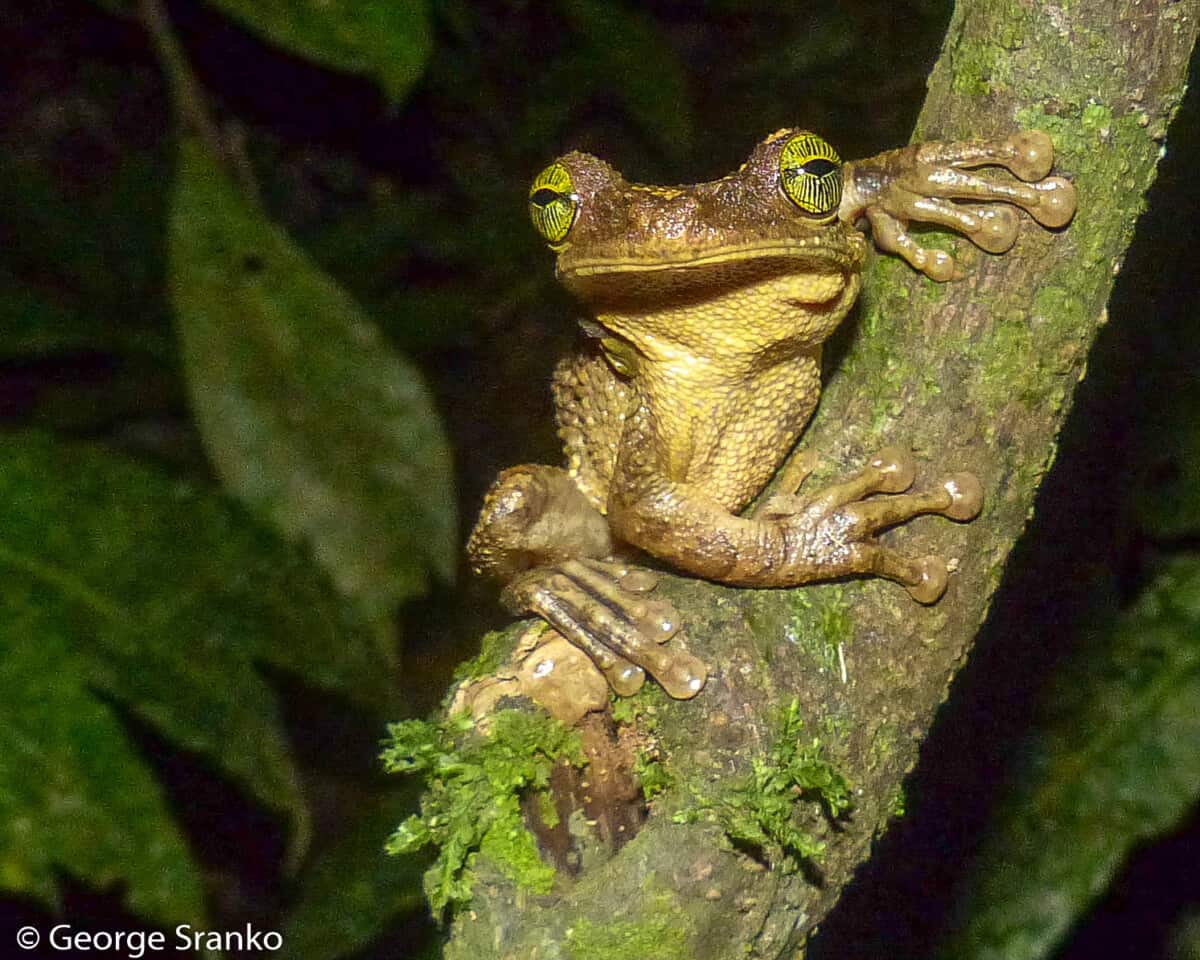After several visits to South America including an Amazon river cruise, and after careful research, we chose a lodge adjacent to Yasuni National Park in Ecuador. This turned out to be one of our top trips for watching wildlife in many years of exploration throughout the world!
The Amazon is remote, involves long flights and has challenges with rain, mosquitoes, and rough terrain. Most animals are hiding deep in the rainforest far from towns and roads. BUT – follow these ten tips for planning your trip and you can see amazing Amazon wildlife even on a moderate budget.
What makes the Amazon so special for wildlife?
South America’s Amazon has the greatest biodiversity in the world, covers 40% of South America, with 4.6 million sq mi spread throughout nine countries. The Amazon contains nearly one third of all the tropical rainforests left on Earth. Even though it only covers about 1% of the planet’s surface, the Amazon is home to 10% of all wildlife species.
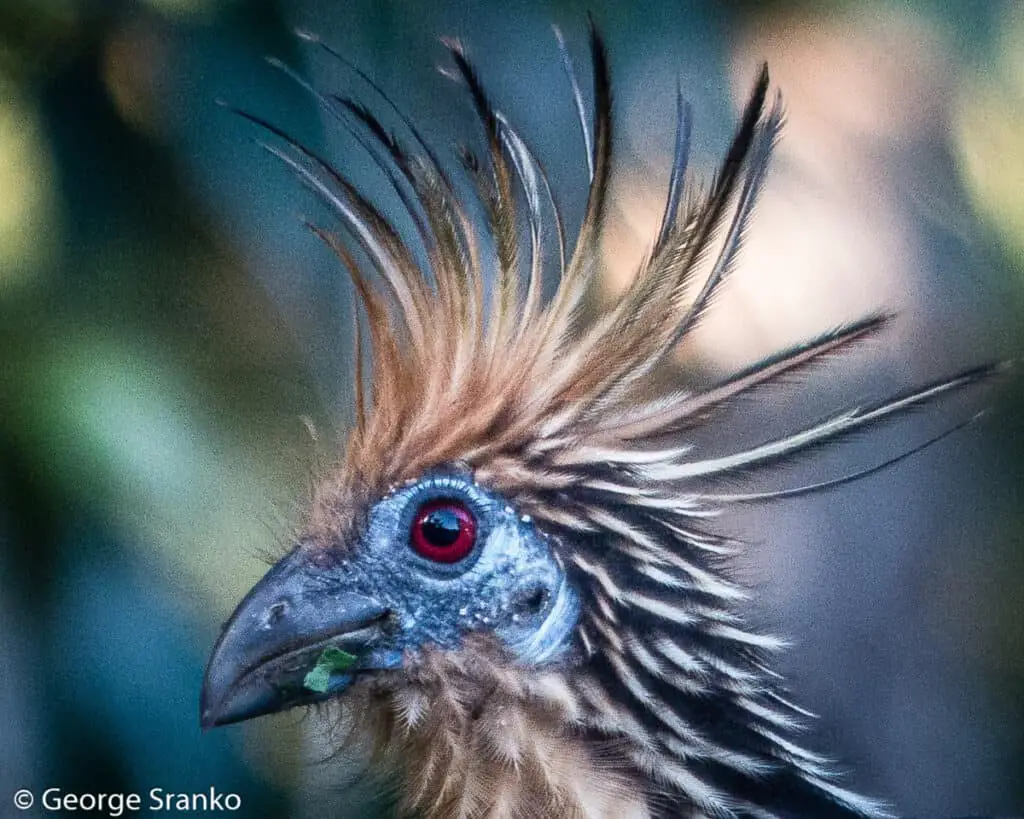
Research by the World Wildlife Fund shows that a ‘new’ species of animal or plant is being discovered in the Amazon every 3 days or so. Tragically, huge parts of the forest are being destroyed at an alarming rate.
If you’ve watched the BBC Earth TV series with David Attenborough canoeing down a jungle river with pink dolphins leaping, Howler monkeys calling, and a rainbow of parrots flying over-head, and wished you could be there — you can do it!

1. Choose your country and destination carefully
You have several choices of country for visiting the Amazon including: Ecuador, Peru, Brazil, Venezuela, Suriname, Bolivia, Guyana, French Guiana, and Colombia. Choose one that is considered safe by checking your government’s Travel Advisory. Places to avoid include areas of deforestation where vast expanses of rainforest are being burned, areas prone to malaria and dengue fever, and places where tourists are targets of violent crimes. Brazil and Peru used to be popular, but Ecuador is a new favorite and the country we chose for our second Amazon wildlife trip.
The Amazon is burning in Brazil: In 2019, around 73,000 km2 of land was burnt in the Amazon rainforest of Brazil, almost double the number in 2018. Unfortunately, corrupt leadership in Brazil is behind this devastation that continues in 2020.
- Where you go will depend on your age and fitness level. It certainly helps to be fit and active when you tackle a trip to the Amazon.
- You will be lucky to find a top wildlife location deep in the Amazon that takes less than two days to access from North America or Europe. International flights will take 10 -20 hours; followed by a local flight to a regional center; and then a four-wheel drive or a motorized canoe to the lodge. Often there will also be a hike or paddle canoe to your remote and amazing lodge. This is where the wildlife lives.
- Check for the shortest and easiest international flights to save time and energy. I recommend an overnight stay after a long flight to recover from jet lag, before embarking on your adventure. Once you arrive at a lodge, wildlife viewing begins at dawn and continues into the evening.
- Lodges will often take care of all your transportation after your flights and carry your luggage to the lodge. This was a relief as our boardwalk was a 20 min trek.
- Be prepared for bad weather and delays. Our trip cancellation insurance saved us a lot of money when fog cancelled a flight and we missed our connection.
- Go with the flow and trust that it is worthwhile. Enjoy!
Welcome to an Amazon Eco Lodge, La Selva
We were welcomed by a toucan calling as we were paddled across a serene lake to the lodge. On the path to our cabin we walked under a tree full of stunning black and yellow crested oropendolas, resting by their big woven nests and singing their liquid vibrato.
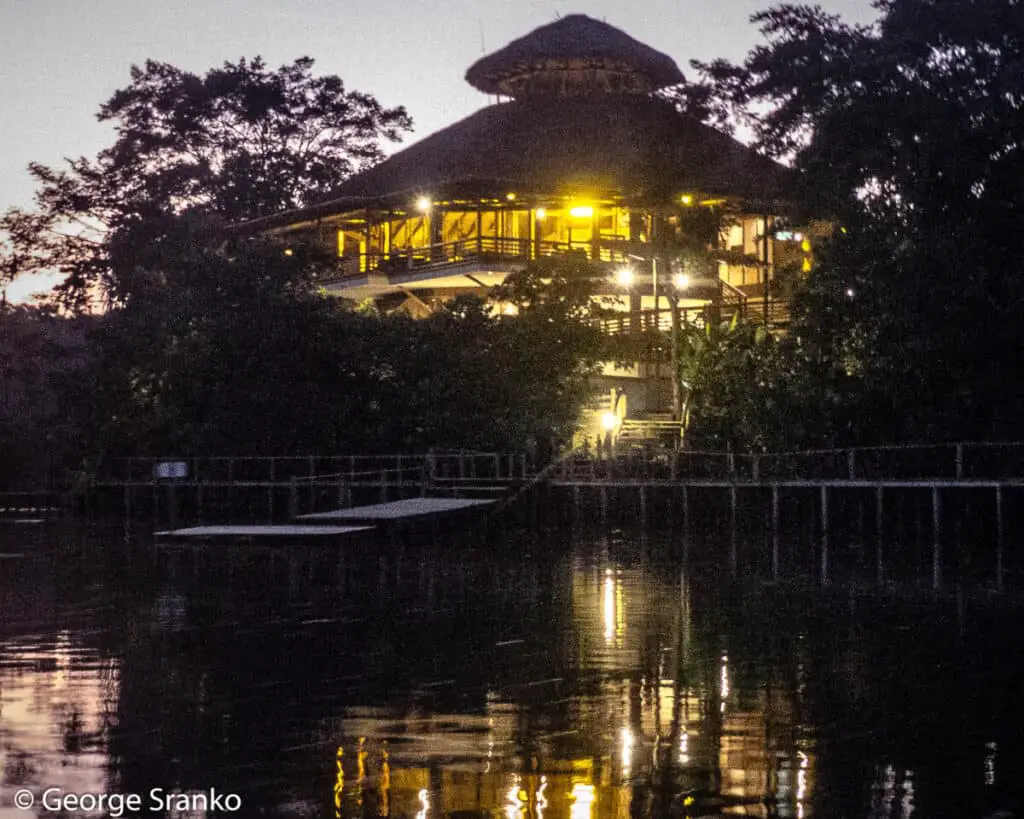
Each of our five days in the Amazon was filled with memories to be treasured: from night paddles with giant bats fishing for minnows across our prow light; to a siesta time spent watching a troop of spider monkeys playing in the tree outside our patio door; to watching green, red and blue parrots avoiding becoming a snake’s breakfast on their clay lick. Our amazing tracker, Enrique, found a four inch marmoset slurping sap from scrapes in the tree bark and our guide, Louis, constantly amazed us with his ability to spot creatures such as a rare and beautiful Agami heron fishing off our bow on a dawn expedition.

2. Stay healthy – do your research
Some Amazon wildlife areas should be avoided if mosquito-borne diseases, such as malaria or dengue, create too large a risk. For an excellent risk assessment, we recommend a government-run health site such as Fit for Travel which provides excellent maps of high risk and low risk areas.
Mosquitoes are the most dangerous creatures in the Amazon. Worldwide they kill millions of people by transmitting malaria, yellow fever, zika virus, and dengue fever.
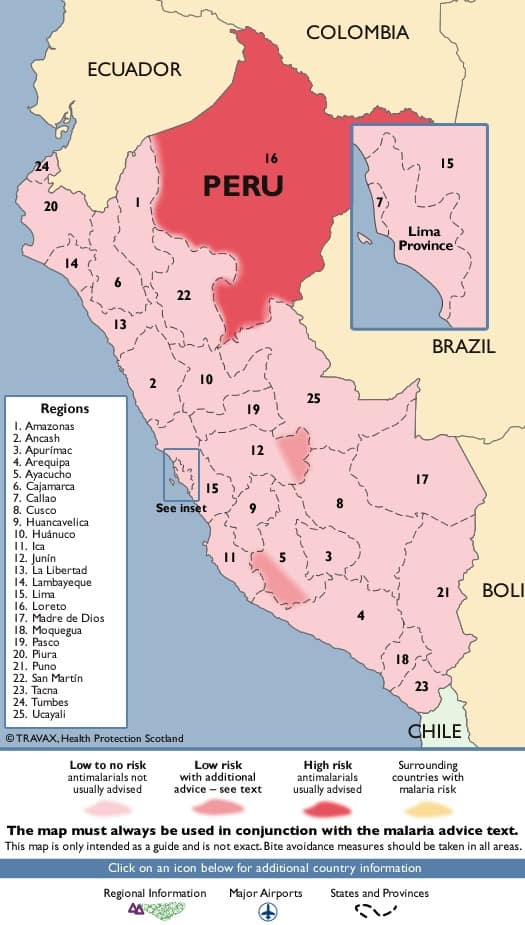

- Mosquitoes come with the rainy season, so try to visit outside of the rainiest times. See our article on weather. Remember lodges want visitors all year round despite the rain!
- At least two months before your trip, check your government’s Travel Advisory to find the vaccinations and medications you’ll need for the area you’re visiting. Some medications, such as typhoid, are administered in stages.
- Yellow fever vaccination is recommended for the Amazon as well as malaria preventatives.
- If you have an adverse reaction to your malaria prevention meds (i.e., Malarone (Atovaquone/Proguanil) made us grumpy!), it helps to have back-up medication from your doctor, or head-to-toe clothing and a head net, as well as DEET if needed.
- Make sure your bed’s mosquito net is free of holes before bedtime. A strong fan helps.
- It pays to research potential locations. The lodge where we stayed was on a lagoon where the pH prevents mosquitos from breeding. I’ve encountered more mosquitoes in Canada, than in the Ecuadoran Amazon in January.
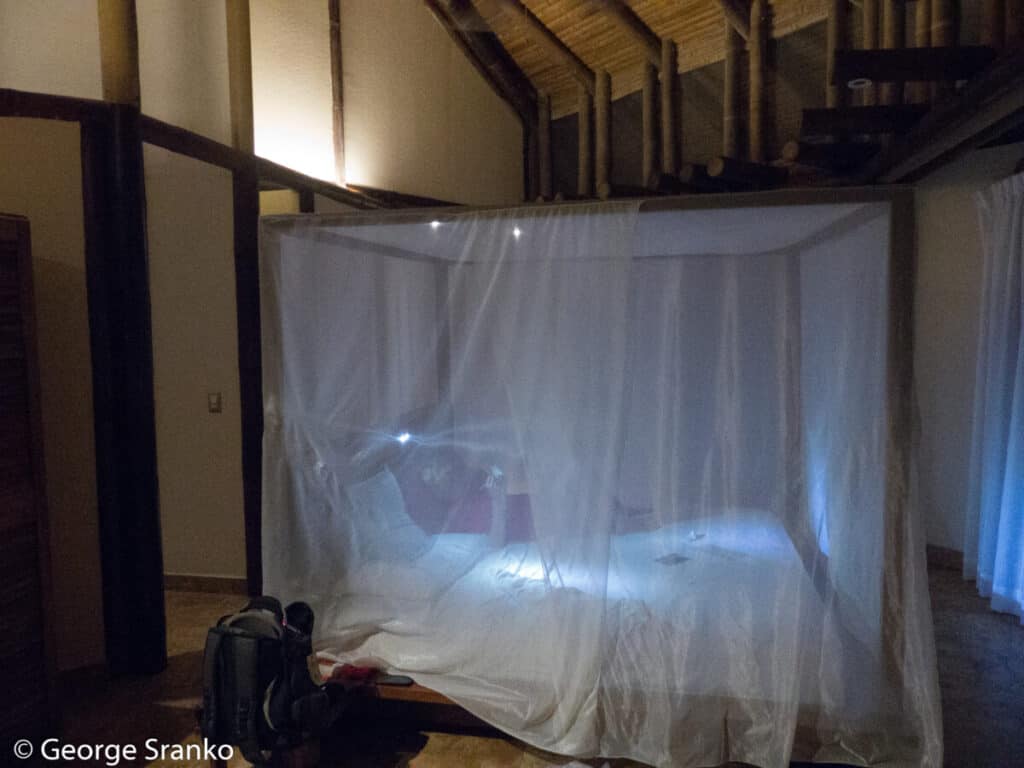
3. When is the best time to go?
Go while you are still active. In our experience, a trip to see wildlife in the Amazon is more physically demanding than going on an African safari. Trails through the rainforest can be challenging and strenuous, and getting in and out of canoes and river boats can be a pain for older backs and joints.

As the Amazon is so huge, there are regional variations in weather that you should research ahead of time. In the equatorial Amazon of Ecuador, it is generally less rainy and less humid in June, July, August and sometimes September. Check Weatherspark.
My first choice for travelling to the Ecuadorean Amazon would be from mid-June to mid-August because temperatures are a little cooler, rain is decreasing, with a lower 55- 70% chance of rain. This period has only 75 – 85% humidity instead of 99%!
In Coca, Ecuador (shortened from Puerto Francisco de Orellana), Weatherspark shows a break in the rainy season with lower rainfall in January. Our lodge was nearby and during our mid-January week we had sunshine, with just one night of rain. We weren’t bothered by mosquitoes.

Find your next destination with perfect weather! Make sure to read our article filled with helpful tools to save you research time and perhaps even heart ache!
4. Jungle hiking can be a fun, but it’s hard to spot animals in the dense foliage
Walking on the short, maintained trails near the lodges is easy. Jungle hiking, on the other hand, is much more demanding as the trails are longer, the terrain can be rough, and may involve bushwhacking with a machete!
At La Selva rainforest lodge, Luis and Enrique, our guide and tracker, saw that we were keen biologists and asked if we’d like to hike in a more rugged area with peccary and capybara. Yes! With gum boots, deep muddy trails, and slippery logs to climb over, it was challenging. I barely managed the rickety branches crossing over a stream. A slip over a log gave me an embarrassing landing in the mud on my behind. I laughed with our sweet local tracker who thought this was hilarious. We saw lots of peccary tracks and one of their bathing holes, but not the shy animals. Still I wouldn’t have missed the experience and we all had a good laugh.
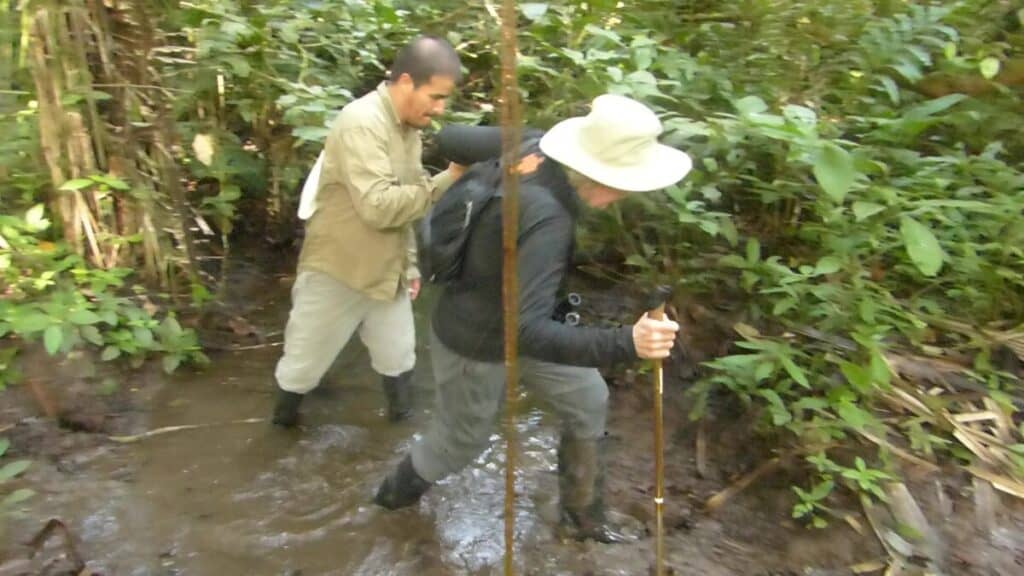
It might be difficult to see wildlife in the rainforest, but there are lots of other interesting creatures, including butterflies, leaf-cutter ants, tree frogs, and colorful birds.
Jungle hiking often involves:
- pushing through thick, tangled vegetation, with numerous trees and vines bearing sharp or spiny leaves
- climbing over huge tree roots and deadfalls on the trails
- crossing creeks on wobbly branches – if you’re lucky! OMG! Any branch to help you across is a luxury!
- squelching through thick mud
- grabbing branches with spines or biting insects! I try to avoid grabbing, squeezing, or falling onto Bullet ants! This is easy to do by accident and you don’t want to mess with the world’s most painful stinging insect to experience agony for 24 hours! (see our article on bullet ants)
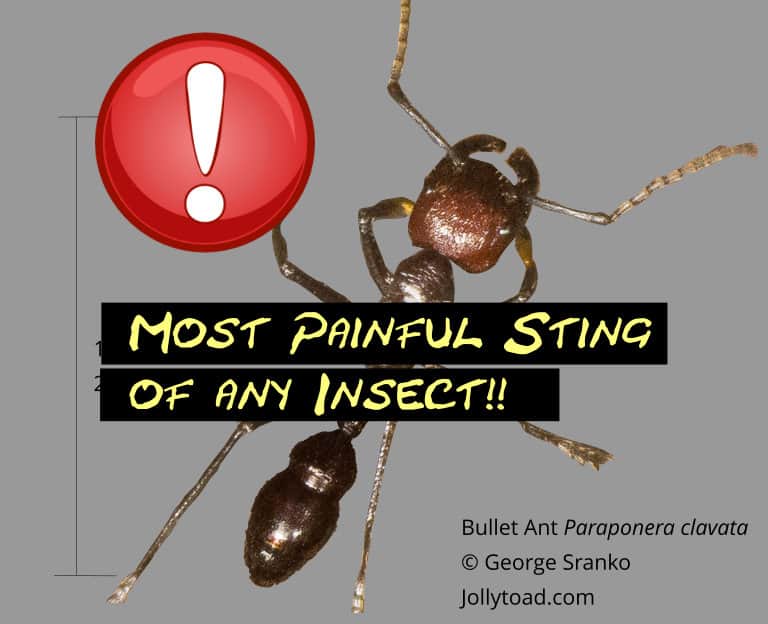
Yasuni National ground is arguably the most biologically diverse spot on Earth. The park is at the center of a small zone where amphibian, bird, mammal, and vascular plant diversity all reach their maximum levels within the Western Hemisphere. Moreover, the park breaks world records for richness of biodiversity on a local-scale (less than 100 km2) for tree species, amphibians, and bat species. It is one of the richest spots in the world for birds and mammals at local scales as well.
Sadly, Yasuni is under threat from oil drilling.
5. Canoeing is quiet and a great way to see wildlife
When we think of the Amazon, we tend to think of dense rainforest and massive trees towering overhead, with vines all around. Our experience on a cruise ship going up the Amazon river to Manaus was completely different – we spent most of the time on a vast expanse of water far from shore. Even the tributaries can be large rivers until you get up into the headwaters. Take the Napo river, for example. If you stay on the river you won’t get to see much wildlife, although you would get to see parrots flying overhead.
If you go trekking through the jungle you are faced with the challenges noted above in tip #4. Canoeing, on the other hand, allowed us to explore small waterways meandering through the rainforest and a lake with plentiful wildlife all around.
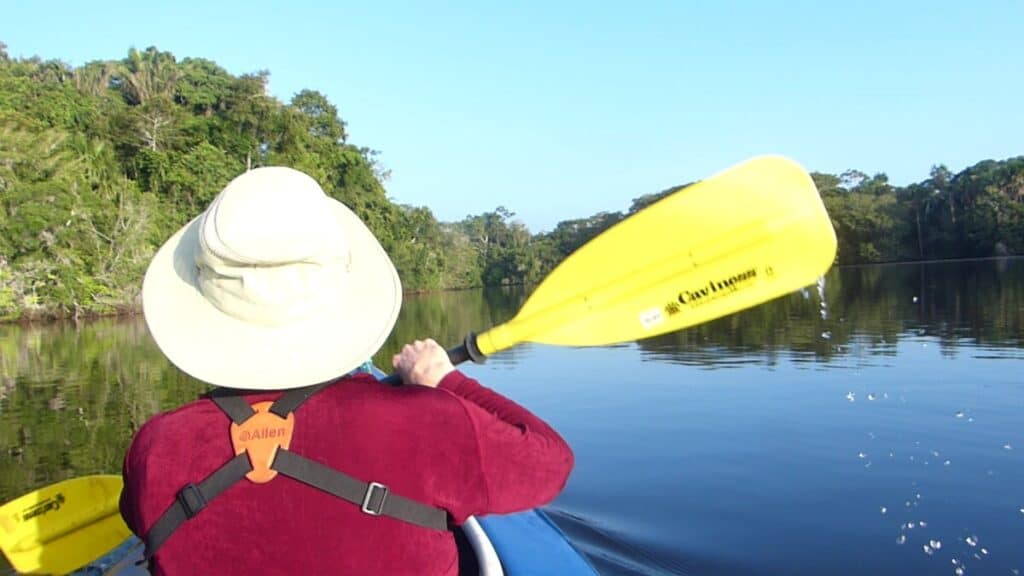
- Canoeing around our lake by the La Selva lodge gave us easy access to all the monkeys, parrots, toucans, caimans and more as the wildlife came to feed and drink along the shoreline.
- We saw most of our wildlife as our guide alternated paddling and pointing; from spider and Howler monkeys to colorful and noisy Hoatzin, known by the locals as “stinky turkeys.” These are fascinating birds with specialized digestive systems that give them the distinctive smell of composting vegetation.
- On a guided dusk canoe ride, we watched tiny bats gobbling insects around our canoe and fishing bats scooping the lake while human-sized fish created giant splashes.
6. Look up! 90% of creatures are high above you in the canopy
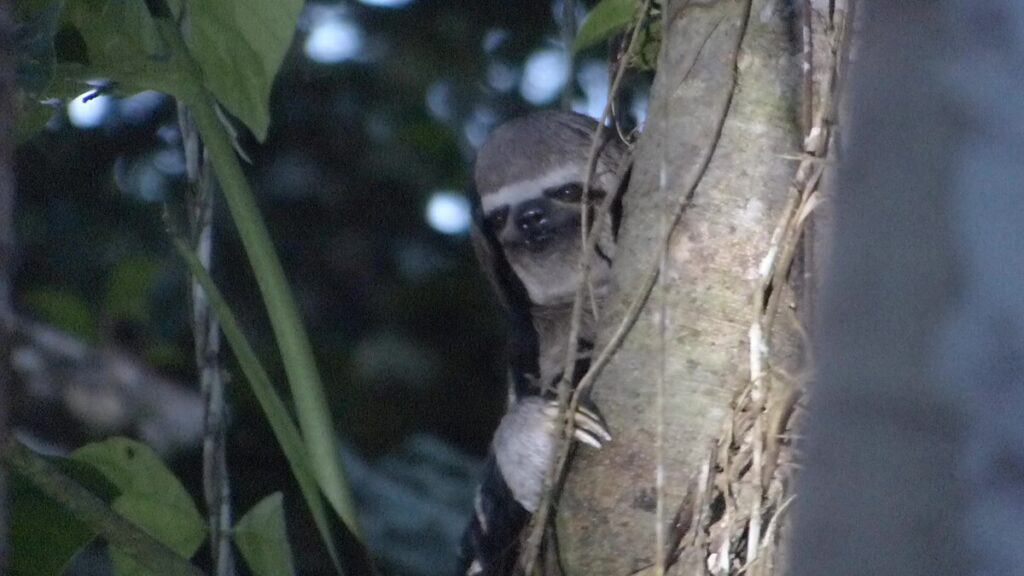
- Good binoculars are essential (I take my favorite travel size Swarovsky’s, but sometimes wish I had a more powerful pair with me- even though heavier, especially when there is help with luggage)
- A lodge with a tower or walkway up to the canopy is wonderful for watching the wildlife, especially the birds as they become active in the morning.
- A lodge on a small lake or lagoon provides easy canoe access to a wide variety of wildlife
- We appreciated having access to the canoes during our free time and enjoyed lovely, quiet paddles on the lake with close-up views of the hoatzin.
7. Many animals are hunted and avoid people
Don’t get your heart set on seeing a jaguar in the wild. They continue to be hunted and will do their best to avoid humans. You would be extremely fortunate to see a jaguar or tapir in the wild!
- Some lodges are installing trail cameras and that would be a great way to watch and appreciate the third largest of the world’s big cats.
- Jaguars are endangered due to deforestation of their territory and poaching. The World Wildlife Fund reports increased Amazon poaching of valuable fangs and claws for the Chinese market.
- Jaguars can be dangerous, however, few people have been killed in recent times. The cause is usually provocation by hunters with dogs.
The word ‘jaguar’ comes from the indigenous word ‘yaguar’, which means ‘he who kills with one leap’.
8. Go with a good guide
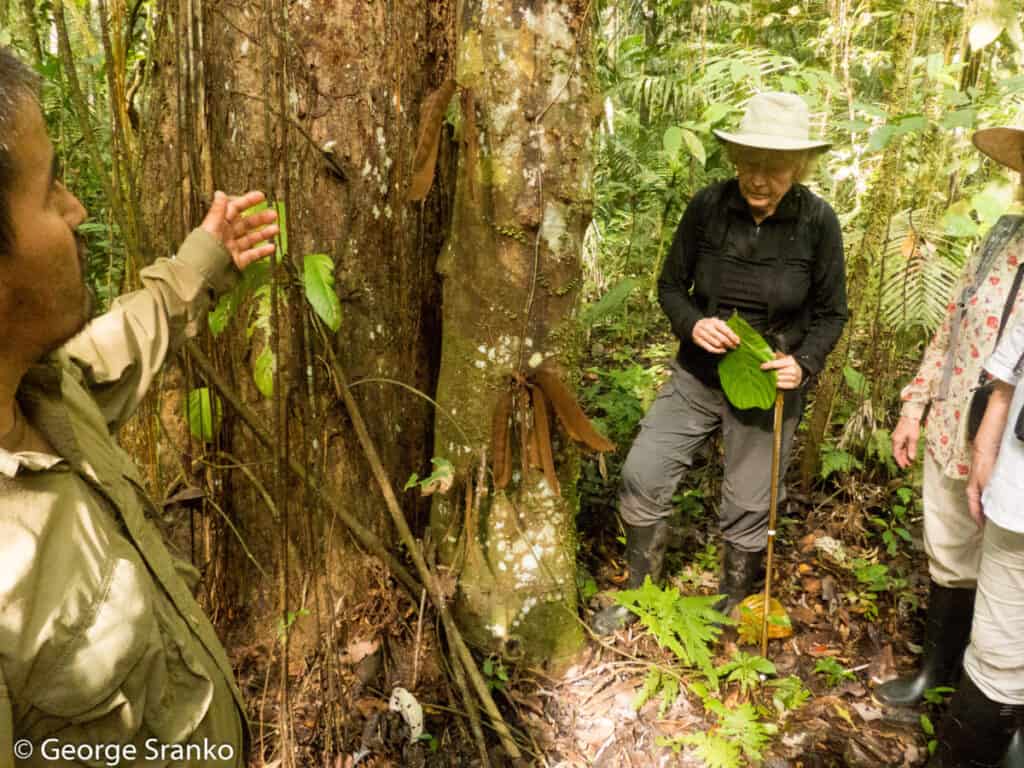
At La Selva, we were fortunate to have Luis as our expert naturalist guide and Enrique as our native tracker. When they heard that we had a 24-hour flight delay and paid hundreds extra to arrive on Sunday rather than Monday, they gave up their break. After supper they took us canoeing at dusk on the lake to see the amazing wildlife show. Little frogs with big voices bellowed over the cricket chorus. Shy red eyed caimans shyly slipped below the surface as we approached, then a five-foot fish jumped out beside our canoe and splashed us.
A dozen little night hawks left their overhanging branch to join little bats gathering dinner. They did a ballet around our lit-up canoe gathering flying insects into open mouths. Then the prima donnas, fishing bats, with wingspans over two feet (61 cm) swooped and scooped up surface minnows.
- Your guide and local tracker know where to find the wildlife based on their knowledge of the seasons, animal movements, and local observations.
- You can easily hear and see monkeys, hoatzin (stinky turkeys) and other large birds but most of the wildlife is camouflaged. In our experience sloths, marmosets, herons, little bats, frogs, and many insects are effectively hiding from you until your guide points them out.
- The good naturalist guides are often mentioned in the lodge reviews because you’re guaranteed to see more wildlife – read the reviews to get a good idea of the sightings and experiences you can expect.
- Guides and local trackers also know the best time to observe the animals. After noticing scrapes in the bark high on a tree during the day, our guide took us back at dusk for a real treat! We had an amazing time watching the smallest monkey in the world! – a Pygmy marmoset licking sap from those scrapes.

9. Small quiet groups see more wildlife
A maximum group size of 6 – 8 people is ideal for keeping the noise level down and for seeing more wildlife. Beware of cheaper tours with higher numbers.
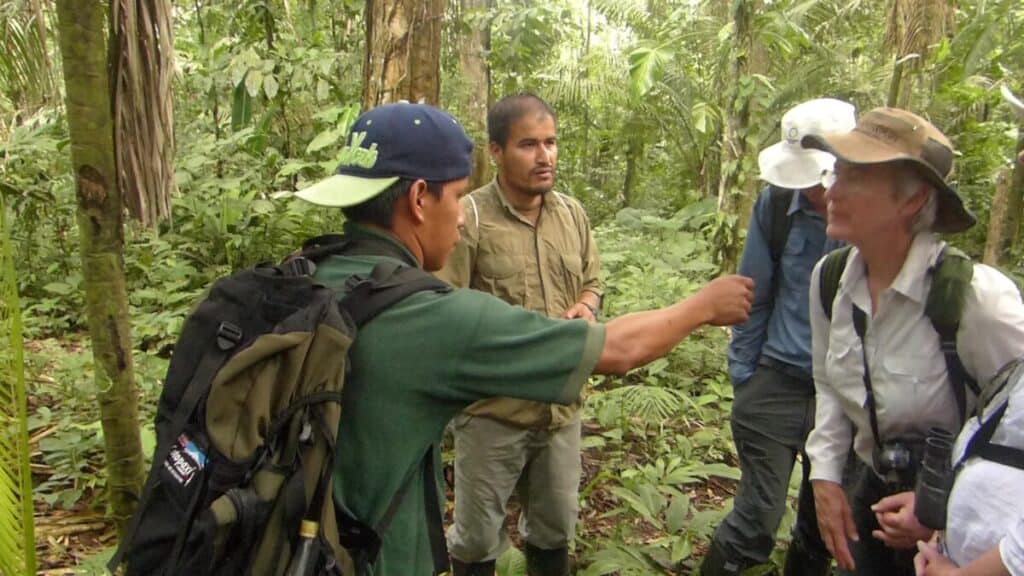
- Animal viewing from motorboats is less effective. The exception is when travelling on the large rivers to watch parrots congregate at the “clay licks”.
- For a quiet trip you may want to join a small bird watching group. Usually they will gently explain to chatty newcomers the importance of not frightening the birds with loud talking.
10. A variety of activities means more opportunities to see wildlife
We had an amazing variety of activities at La Selva and saw different creatures each time.
- Early morning canoe trips to different locations
- A speed boat trip to a “clay lick“ to watch flocks of parrots gathering minerals
- A climb up onto a birding tower high in a kapok tree, with help identifying many new species
- An easy hike in the rainforest and a more challenging hike tracking peccaries and learning about the native uses of plants
- An evening paddle with fishing bats and nighttime viewing of sloths in the trees with a flashlight
- A guided evening walk to check out the nocturnal forest creatures such as the beautiful tree frogs and insects

Don’t miss an evening event. Plentiful nocturnal wildlife starts feeding at dusk. There are marmosets, spectacled owls, little bats and amazing fishing bats to be seen from a canoe. On a night walk with flashlights you can find colorful tree frogs, moths and if you’re lucky a nine-banded armadillo. Feeding at night, you might see cute little wild cats called margay and monkey-like honey bears swinging through the trees.
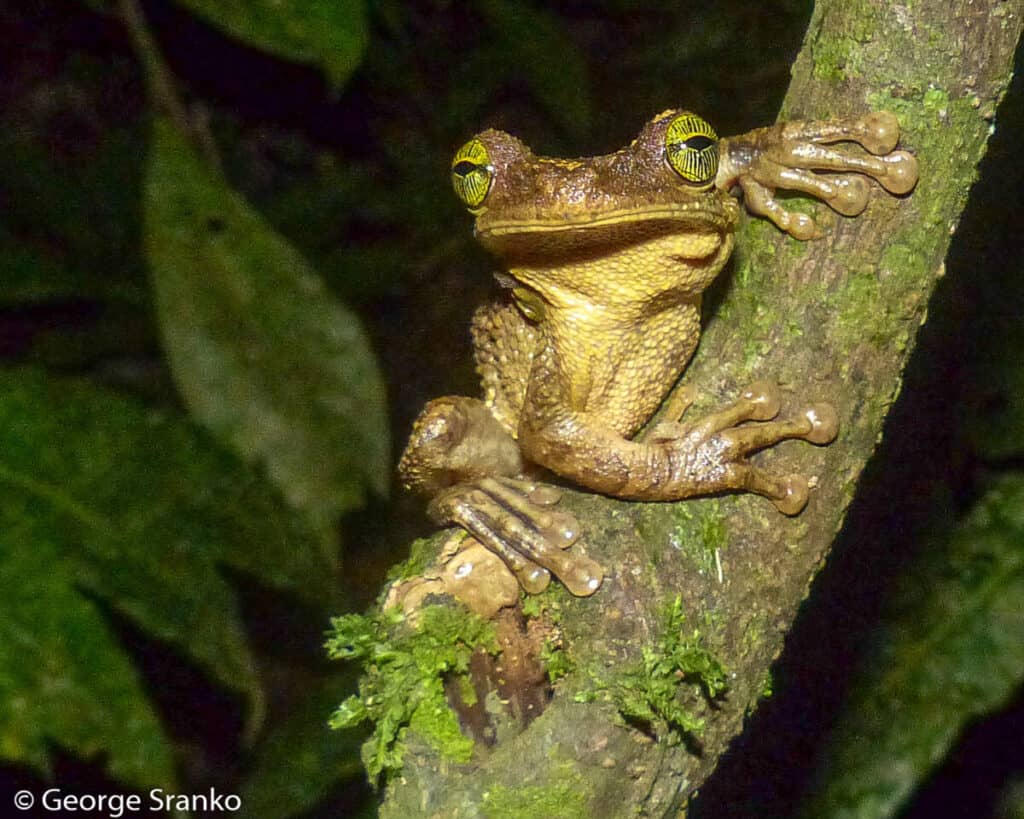
Some final things to keep in mind
The lower Amazon vs the upper Amazon
This is a distinction that many travelers might not be aware of. You can have a great cultural experience on the lower Amazon river; however, it is not the greatest if you are interested in viewing wildlife. The Amazon river is immense and is used by ocean-going vessels downstream of Manaus. In fact, Manaus is considered a deep seaport even though it is 1,000 miles (1,600 km) from the Atlantic Ocean!
Upriver from Manaus, you can find the smaller tributaries and the rainforest lodges that provide the iconic Amazon wildlife experiences.
Can you see wildlife from a cruise ship on the Amazon?
In general, you’ll see more wildlife at a rainforest lodge. Our first trip through Brazil on the Amazon river was interesting – but not a great wildlife viewing experience. Getting a Brazilian visa on short notice was not a piece of cake given the paperwork and trips to the embassy.
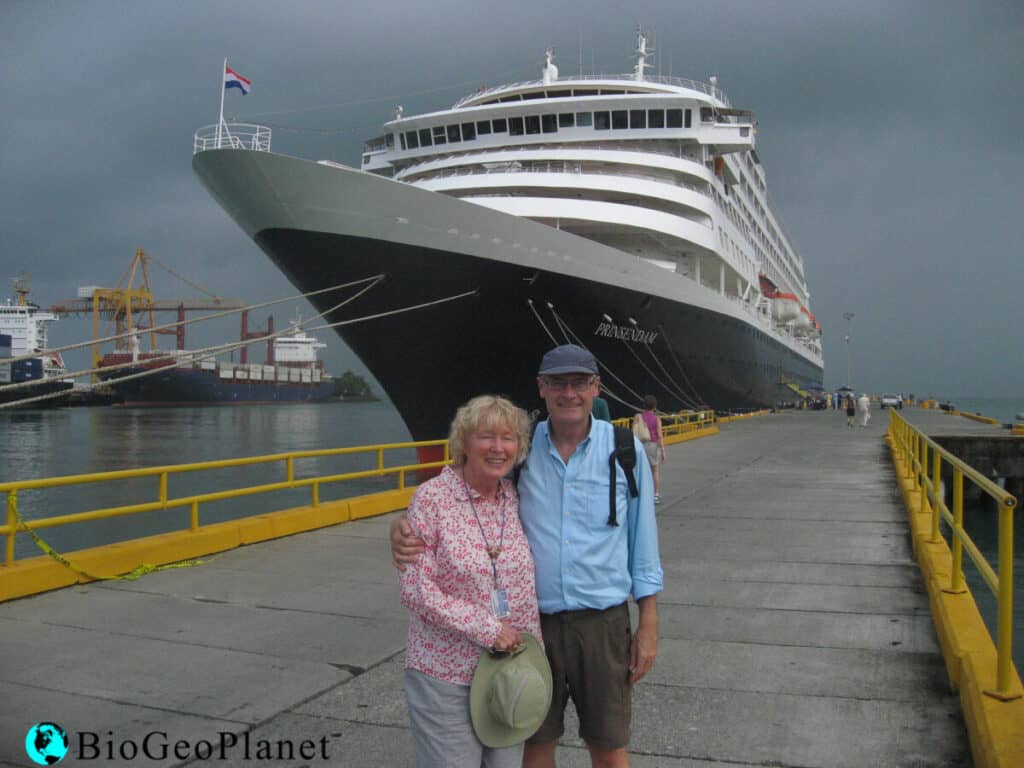
We went on a lovely cruise and stopped at interesting villages. For 10 days travelling from Bellum to Manaus and back on the Amazon river, the river was up to twenty miles wide so we really didn’t get to see as much wildlife from the ship as we thought we might. However, we did get to see a Pink dolphin!
When we stopped in Manaus, we were warned that it could be dangerous, so we arranged for a dawn birding trip from the cruise dock. We spent three wonderful hours in the wetlands and saw toucans 300 yards away. Sadly, three passengers had watches or jewelry stolen. We ran into similar problems in Lima Peru.
Why Choose Ecuador for an Amazon Trip?
Our third trip to South America was to Ecuador where we fell in love with the country and its people. Ecuador cares for it parks and wildlife and was the first country in the world to recognize the Rights of Nature in 2008. Sadly, the Ecuadorian Amazon is not safe from exploitation – even within Yasuni National Park.
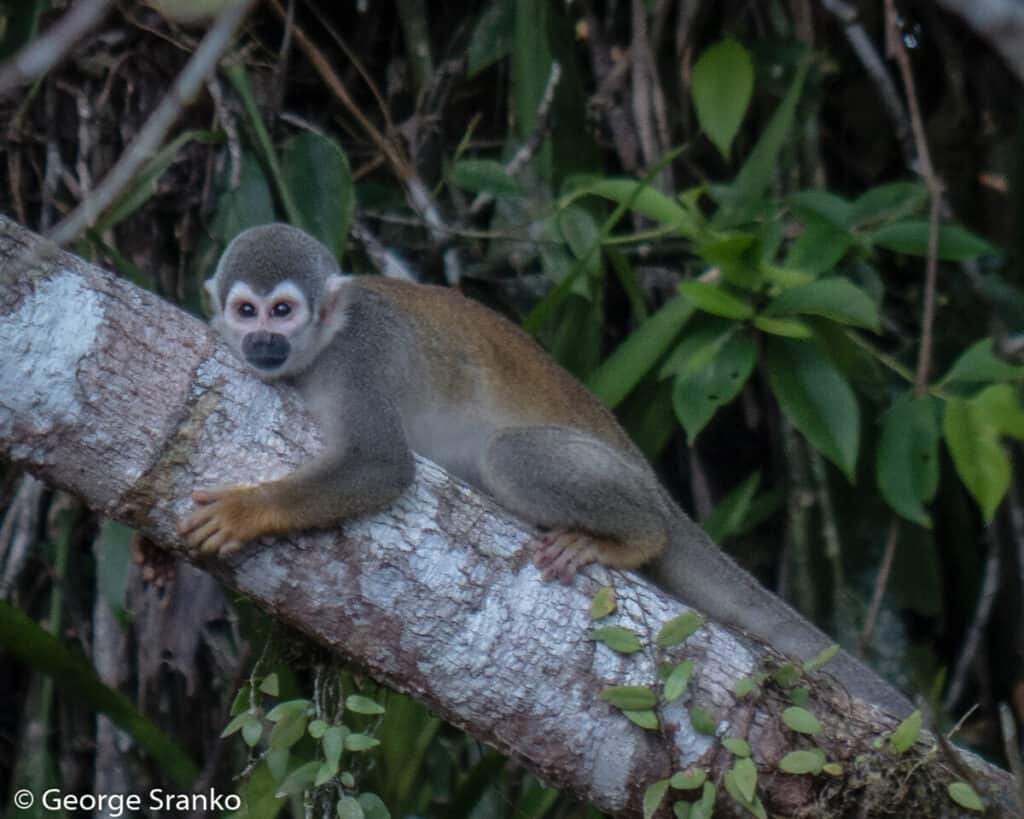
Not only does Ecuador have the Amazon, it has the Galapagos!
Contrary to common belief, you CAN take a reasonably priced wildlife trip to the Galapagos as well as enjoying the friendly village of Puerto Ayora, Ecuador. All the people we met were friendly and helpful. Whenever we went out in the evening for dinner, the streets were safely filled with families eating out on street tables.
I didn’t think anything could be as stunningly beautiful as the Galapagos, but the Ecuadorian Amazon wildlife experience was a delight.
Check Out Our TOP Articles for Even More Fascinating Creatures
- How do Octopus Reproduce? (Cannibalistic Sex, Detachable Penis)
- Do Jellyfish have Brains? How Can they Hunt without Brains?
- Why are Deep Sea Fish So Weird and Ugly? Warning: Scary Pictures!
- Are Komodo Dragons Dangerous? Where Can you See Them?
- Koala Brains – Why Being Dumb Can Be Smart (Natural Selection)
- Why do Lions Have Manes? (Do Dark Manes Mean More Sex?)
- How Do Lions Communicate? (Why Do Lions Roar?)
- How Dangerous are Stonefish? Can You Die if You Step on One?
- What Do Animals Do When They Hibernate? How do they Survive?
- Leaf Cutter Ants – Surprising Facts and Adaptations; Pictures and Videos
- Irukandji Jellyfish Facts and Adaptations; Can They Kill You? Are they spreading?
- How to See MORE Wildlife in the Amazon: 10 Practical Tips
- Is it Safe to go on Safari with Africa’s Top Predators and Most Dangerous Animals?
- What to Do if You Encounter a Bullet Ant? World’s Most Painful Stinging Insect!
- How Do Anglerfish Mate? Endless Sex or Die Trying!
- How Smart are Crocodiles? Can They Cooperate, Communicate…Use Tools?
- How Can We Save Our Oceans? With Marine Sanctuaries!
- Why Are Male Birds More Colorful? Ins and Outs of Sexual Selection Made Easy!
- Why is the Cassowary the Most Dangerous Bird in the World? 10 Facts
- How Do African Elephants Create Their Own Habitat?
- What is Killing Our Resident Orcas? Endangered Killer Whales
- Why are Animals of the Galapagos Islands Unique?
- Where Can You See Wild Lemurs in Madagascar? One of the Best Places
- Where Can You see Lyrebirds in the Wild? the Blue Mountains, Australia
- Keeping Mason Bees as Pets
- Why do Flamingos have Bent Beaks and Feed Upside Down?
- Why are Hippos Dangerous? Why Do They Kill People?

